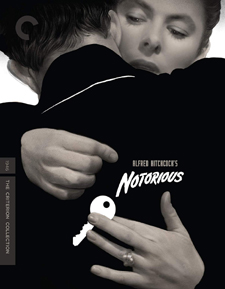Notorious (Blu-ray Review)

Director
Alfred HitchcockRelease Date(s)
1946 (January 15, 2019)Studio(s)
RKO Radio Pictures/Vanguard Films (The Criterion Collection - Spine #137)- Film/Program Grade: A
- Video Grade: A
- Audio Grade: A
- Extras Grade: A+
Review
Made right after World War II and the beginning of the Cold War, Notorious is a spy thriller with a romantic sub-plot, built on themes of betrayal, loyalty, deceit, honor, and patriotism. Alicia Huberman (Ingrid Bergman) is a patriotic American whose father is a convicted Nazi spy. Known for heavy drinking and promiscuity, Alicia is recruited by an American agent named Devlin (Cary Grant) to fly to Rio and infiltrate a spy ring of National Socialist conspirators led by her former lover Sebastian (Claude Rains). Devlin asks her to use sex to discover what secrets Sebastian may be concealing. Sebastian loves Alicia. Alicia and Devlin fall for each other but Devlin exploits her love to force her into the arms of another man.
Known for visual story telling, director Alfred Hitchcock is at his best as his subjective camera uses close-ups to reveal characters’ thoughts and advance the plot. Employing longer takes than usual and judicious editing, Hitchcock causes us to feel the mounting tension. The director used two of the most glamorous stars of the era to soften the hard edges of their characters. He keeps us wondering about the motives of the enigmatic Devlin and makes a point of portraying Alicia’s loose, free-living lifestyle. These are not typical romantic drama characters of the era, but complex, imperfect individuals forced into situations over which they have little control.
Ms. Bergman conveys Alicia’s allure and ambiguity and her dramatic path from hedonistic playgirl to pawn of scheming male characters to conventional romantic figure. She delivers real emotion and her scenes with Grant, especially a lengthy one involving multiple kisses, sends off sparks. Grant and Rains are both fascinating, Grant as a man who must place patriotism over personal feelings and Rains as a suave yet dangerous rival for Alicia’s affections. Madame Konstantin as Sebastian’s cold German mother and Reinhold Schunzel and Ivan Triesault as Nazi conspirators fill out the cast of hissable villains.
The Criterion Collection Blu-ray features a new 4K digital restoration with uncompressed monaural soundtrack. The transfer was sourced from the original 35-millimeter camera negative, a 35-millimeter fine-grain, and a 35-millimeter safety fine grain. There are no visible imperfections in the print. Blacks are rich and there is good delineation among shades of grey. A sequined outfit by Bergman pops nicely and several shots feature noir-style lighting. Aspect ratio is 1.37:1. Optional English subtitles are provided for the main feature.
Special Features:
Audio Commentary #1 – Film historian Rudy Behlmer notes that David O. Selznick brought Hitchcock from England in 1939. Hitchcock made 3 films for the producer before Notorious. Behlmer provides background on the film, evolution of the script, collaboration of writer Ben Hecht with Hitchcock, casting and filming, Hitchcock’s approach and stylistic touches, and the interaction between Selznick and Hitchcock.
Audio Commentary #2 – Alfred Hitchcock scholar Marian Keane provides an academic deconstruction of the movie. She gives a shot-by-shot discussion of subjective point of view, notes the importance of close-ups to reveal characters’ thoughts, and analyzes the story, character motives, conflicts, and relation of camera to delivery of dialogue.
Once Upon a Time… Notorious – The film is a “love story woven into a spy drama.” A synopsis is provided along with clips from the movie and political background of the times. Hitchcock’s three anti-Nazi films made prior to Notorious are mentioned and there’s a brief overview of the director’s career. Bergman’s character was based on the World War I spy Marthe Richard. The use of Uranium 235 as a key plot point caused the FBI to tail Hitchcock. Brief clips are shown from Hitchcock’s Memory of the Camps documentary in which he edited footage taken of the horrors of the concentration camps. Selznick disliked the plot and sold the entire package – story, stars, writer – to R.K.O. From archival interviews, Hitchcock notes that “film should be made on paper ahead of time” and “assembling pieces of film to create fright is my job.”
Powerful Patterns – Stylistic threads in the film are noted. Selznick influenced Hitchcock to make his films more romantic. Editing in Notorious relies on long takes, a technique employed by other directors of the time (Welles, Wilder, Sturges). Subjective camera is discussed and examples from other Hitchcock films are shown.
Glamour and Tension – Hitchcock combines suspense with traditional Hollywood elegance. The atmospheric cinematography by Ted Tetzlaff is discussed. Props and set design are dramatically tied into the action. Resolution of the plot is not in dialogue but in visuals.
Poisoned Romance – The film poses a series of questions: When does patriotism border on exploitation? When does espionage border on poisoned fidelities? When does flirtation border on sexual blackmail? Motifs and themes are explored.
Writing With the Camera – Selznick introduced Hitchcock to storyboarding, which the director had never used in his British films. It became a favorite tool of Hitchcock’s, causing him to “edit in the camera” – shooting just the shots he wanted without excessive coverage. A few Notorious storyboards are shown on the left with actual scenes from the film on the right.
Newsreel – This 1948 Pathe Reporter Meets… newsreel shows Hitchcock and Ingrid Bergman arriving in England by plane. Hitchcock makes a few comments for the assembled press.
Booklet – This accordion-style insert contains the analytical Notorious essay The Same Hunger by Angelica Jade Bastien, 3 black-and-white photos (of Bergman, Grant, and Rains), and a cast and key crew personnel list.
Trailers – Four different Notorious trailers are included.
– Dennis Seuling

